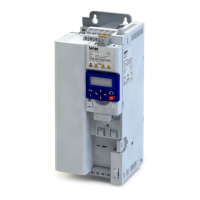11.1.1.3 Example 3: Pulse train as frequency setpoint source
This example shows a conguraon to control the frequency setpoint of the inverter via pulse
train:
•
Switch S1 starts the motor. Switch S1 in the inial posion stops the motor again.
•
Scaling of the pulse train signal: Input range -85 ... 85 kHz ≡ seng range -50 ... 50 Hz
•
HTL input monitoring is congured in such a way that a warning is output if the pulse train
signal falls below the minimum input frequency of 10 kHz for longer than 2 s.
Connecon plan Funcon
GND
AI1
AI2
AO1
10V
24V
DI1
DI2
DI3
DI4
DI5
DO1
X3
S1
Controller
COM
PTO2
PTO1
CCW
CW
Switch S1 Run
PTO1 Pulse train output of the Controller
PTO2 Specicaon of direcon of rotaon of the Con-
troller
Parameter Designaon Seng for this example
0x2631:001 (P400.01) Enable inverter Constant TRUE [1]
0x2631:002 (P400.02) Run Digital input 1 [11]
0x2630:002 (P410.02) Sengs for digital inputs: Input funcon Pulse train/direcon [3]
0x2860:001 (P201.01) Frequency control: Default setpoint source HTL input [4]
HTL input sengs
0x2640:001 (P415.01) Minimum frequency -85000.0 Hz
0x2640:002 (P415.02) Maximum frequency 85000.0 Hz
0x2640:003 (P415.03) Minimum motor frequency -50.0 Hz
0x2640:004 (P415.04) Maximum motor frequency 50.0 Hz
HTL input monitoring
0x2641:001 (P416.01) Minimum frequency threshold 10000.0 Hz
0x2641:002 (P416.02) Minimum delay threshold 2.0 s
0x2641:005 (P416.05) Monitoring condions Below minimum frequency [1]
0x2641:006 (P416.06) Error response Warning
I/O extensions and control connecons
Congure digital inputs
Congure digital inputs DI3/DI4 for detecng a pulse train
253

